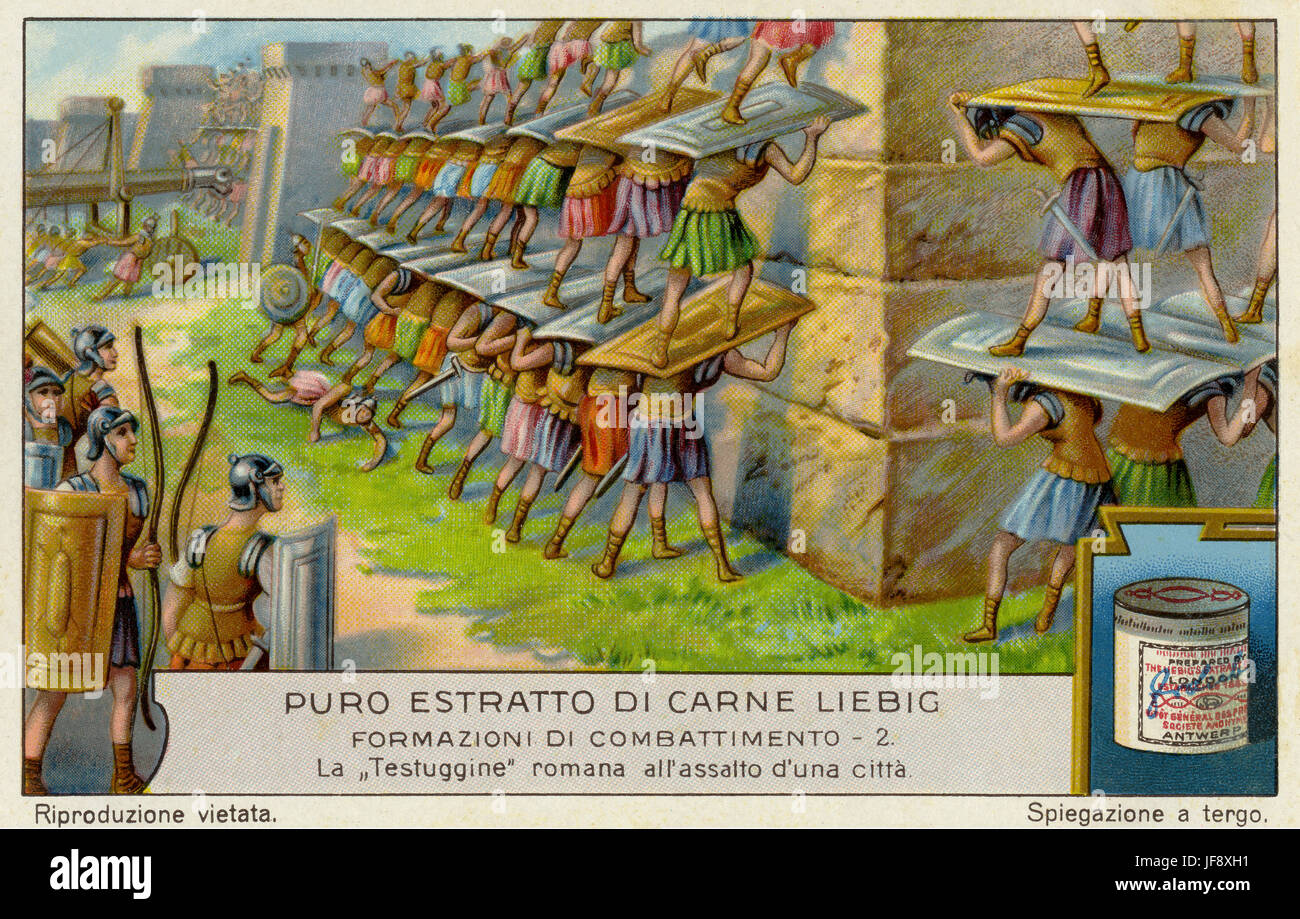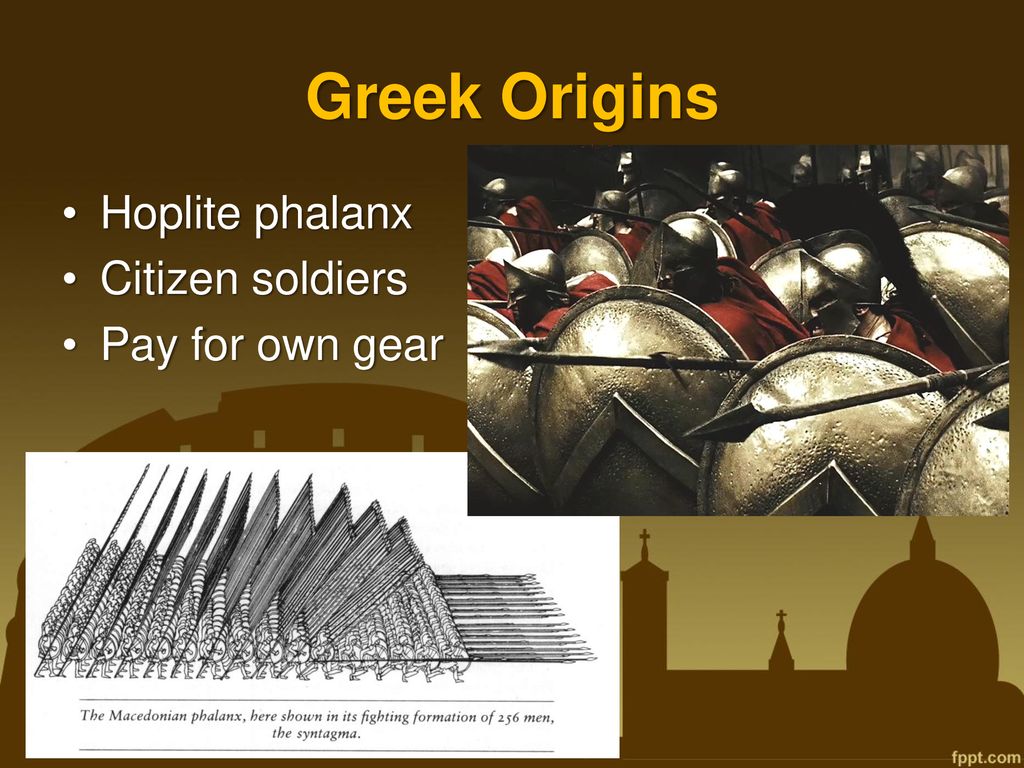Roman Military Formation - The organization of Homeric-style heroic warfare to close-knit hoplite warfare changed the world. This powerful Hellenic formation enabled the ancient Greeks to repel the powerful Persian invasion and spread Hellenic culture in the Mediterranean. The Macedonian phalanx took the concept of cohesive group warfare to another level with the saris armed phalangites and under Philip and Alexander shook all opponents before them.
While Alexander's empire grew and fell, the Romans were busy with their difficult task of conquering Italy. Initially adopting the hoplite-style phalanx due to the influence of the southern Italian Hellenic colonies, the army eventually transformed into a flexible manned legion. This transformation was probably the result of the Samnite wars, which were fought in the varied mountainous terrain of central Italy, where the Romans needed a more adaptable formation.
Roman Military Formation

The Roman manipulative legion and the Macedonian phalanx were key factors in the success of their respective states, but is one formation actually better than the other?
Chapter 4: The Battle Of Cannae
The best descriptions of the formations come from the historian Polybius. Raised in ancient Greece, Polybius fought in the Hellenic battles before being sent as a hostage to Rome, although he was given great liberties during his stay. Polybius studied Roman warfare in Rome and thus had experience with phalanx and manipula warfare.
In his stories, Polybius directly refers to the strengths and weaknesses of both formations. For the phalanx, the sixteen-man deep formation had the first five ranks with their spears extended out of formation, while the remaining ranks held their spears upright or at an angle to launch missiles. The close formation with the average phalangites occupying a front of three feet meant that, in theory, the average soldier, who needed twice as much front to operate a sword or spear, faced a total of ten spear points.
Not a purely defensive formation, the phalanx could continue forward with pikes cutting through almost any enemy with ease. Polybius says that the greatest weakness of the phalanx is its uselessness on rough ground, but we know that under the skillful leadership of the phalanx it won victories even when crossing rivers.
The formation of the Roman Manipulators had a rather unique layout. With three lines, one behind the Romans in separate maniples arranged with each row having a manipul-sized gap between units, with those gaps of the next row covered back to create a checkerboard formation. The exact manner of this training to engage in battle has been questioned due to large gaps, but gaps appear to have remained as he was committed to supporting the rear lines if needed.
Renaissance Warfare: A Military Revolution
There are several key differences in the formations. Manipule was fluid, with each manipule led by centurions who were encouraged to take initiative and lead by example. The phalanx was much tougher, but overwhelmingly powerful in a frontal attack. The individual phalanx soldier was bound to the cohesion of his unit, but had the security of many spearheads between the front rank and the enemy.
The individual Roman had more room to operate, with a large shield and effective sword allowing them to confidently fight and defend individually and as a group by locking shields. Spears thrown by the manipula were also effective formation-breaking tools used to reduce the impact of enemy charges or create holes for exploitation by one's own charge.
The two formations have met several times in battle with different results. The first battles were during Pyrrhus' invasion of Italy in 280 BC. Three major battles were fought in addition to Pyrrhus' first two victories. At Heraclea and Asculum, the tried and true Macedonian phalanx faced the Roman manipula, which had only been established 40-100 years earlier.

Pyrrhus won these battles, but the Maniples made a strong effort and inflicted heavy casualties. At the Battle of Beneventum a few years later, the Romans were finally victorious, aided by Pyrrhus' elephants, who retreated back into their ranks. Details for these battles are scarce, but although it appears that even if the phalanx did get through the Romans, it was done with great difficulty, and at Beneventum the flexibility of the manipula allowed them to open a hatch to trap the elephants and cause a red. .
Roman Tortoise Hi Res Stock Photography And Images
After Pyrrhus' invasion, the Romans waged titanic wars against Carthage, which elevated them to superpower status in the Mediterranean. Just after the end of the Second Punic War, the Romans invaded Macedonia to fight Philip V, who had been an ally of Carthage and was now harassing the Hellenic cities allied to the Romans. The armies of Rome and Philip's phalanx met at Cynoscephalus, with a large hill separating the two camps.
Philip decided to take the initiative and marched first with the right half of the phalanx so that they could take the hill and descend. When the Roman left met and held them, the Roman right marched up the hill to deny the rest of Philip's army a downhill advantage. As they advanced, the unnamed officer noted that they were marching right up against the vulnerable rear of the Macedonian right phalanx and cut off a force large enough to flank the infected phalanx and quickly route it.
Meanwhile, the remaining Roman right wing advanced up the hill and met the rest of Philip's army as they approached. The flexibility of the manipulator allowed them to surround and destroy any unit until the rest of Philip's forces fled. This battle shows the ingenuity and liberties allowed to Roman officers to enable them to make a decision on the battlefield that profoundly affected the outcome.
The last great example of a manipula-phalanx battle is found in the Battle of Pydna during the Third Macedonian War between Rome and Perseus. The decisive battle takes place on flat ground not far from Thermopylae. The Macedonians outnumbered the Romans 44,000 to 29,000, but both forces were equal in cavalry.
Cloud Architectures: The Strategy Behind Homogeneity
The two armies lined up, each dividing the cavalry on the wings and advancing towards the Macedonian phalanx. The Roman infantry met the phalanx and did not break, but were constantly driven back to the broken ground behind them. As the long line of the phalanx pushed forward they began to break up the formation as some areas pushed forward more than others and the uneven ground began to break up the formation.
At first the Romans in small groups dived into these narrow gaps in the ranks and struggled to widen them. As the gaps grew, more, probably fresh, men from the rear ranks were fed to completely infiltrate the dozens of phalanx segments and the Macedonians were soon crushed. The cavalry fight was indifferent, but as soon as the infantry ran, the cavalry followed.
This final battle shows the small unit tactics that the manipul was made for, but also shows how well the manipul suited the Romans as a people. The Romans were very brave and it took a lot of courage to be the first to jump into the enemy formation spraying spears to open holes for your comrades.

The battles certainly show the flexibility of the constructed legion over the powerful but rigid Macedonian phalanx, but it would be impossible with all the different variables to find a perfect battle match between the two formations. Each of the listed battles has different skills and experiences for commanders and the army in general.
Military Tactics That Made Alexander, The Great
The Macedonian phalanx continued to be used by Germany and Egypt and proved effective. Even a minimally equipped and trained phalanx was still an advanced force to be reckoned with.
The flexibility of the Roman manipulator allows them to fight in a group of any size from entire legions to a single soldier, ready for any occasion on the battlefield with two spears, a large shield and an efficient gladius. The tactics of ancient Rome were so terrible for their time that even after 2000 years they are still taught by military schools and colleges around the world. Although the organization of troops used by the Romans was preceded by the Greeks of Macedonia, the Romans raised this organization to a new level. Many would argue that the success was the standardization of equipment and training, including different commands that each unit immediately understood.
As the Roman Empire grew, so did military tactical tools. Although extremely adaptable, there were three tactics that would endure for the duration of this great empire.
In its old age, the wedge was an extremely effective offensive military formation. It was designed to break through enemy lines and confuse their cavalry. The legionnaires would form a triangle shape pointing at the enemy and charge straight through the enemy. Each soldier was close enough to his next comrade in formation that they could defend and protect each other. The main weapon they carried was the gladius (sword).
Space In Formation And Width Of Front Of Roman Legion « Imperium Romanum
When the general shouted « cuneum formate », the legionnaires would form a wedge and charge the opposition. The point of the triangle, aimed directly at the enemy, was from the most experienced and best troops. This
Roman military dress, roman military history, ancient roman military clothing, roman formation, military formation commands, us military formation, roman military armor, roman soldier shield formation, military formation types, roman military, roman military art, formation military
0 Comments